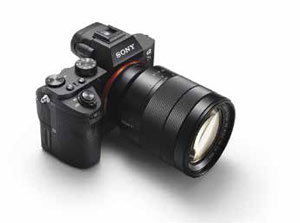articles/Cameras/which-compact-system-camera-page6
You've got to have a system - part 6 of 1 2 3 4 5 6 7
Published 10/04/2015

Sony A7 Mark II
Yes, the A7 has now reached the second generation 'Mark II' stage, and was at the time of handling the one and only full-frame camera with optical five-axis image stabilisation, providing the equivalent of 4.5 stops gain. In terms of improvements over the plain old A7, auto focus response is 30% faster than the previous generation, whilst startup is 40% faster, officially. Coming from an electronics manufacturer it's no surprise that, like the Panasonic GH4, we get both NFC and Wi-Fi connectivity options. In terms of optics, this is an E-mount camera, so boasts compatibility with Sony's existing E-mount (as opposed to A mount, unless you're using an adapter) lens family. There are currently around 22 directly compatible lenses.
A big full-frame sensor in a smaller body than one would usually find housing such a hot property (weight is 556g body only), is once again the main lure for this latest Sony option in its best-selling 'A7' series, available for around £1,500 at the time of writing. Going up directly against the likes of the Fuji X-T1, Olympus OM-D E-M1 and Samsung NX1, the newest A7 model has the advantage on paper at least of incorporating a bigger chip. And there are 24.3 megapixels to play with courtesy of the 35.8x23.9mmm sensor size. Arguably this is a big part of the reason why Sony's A7 series has proved so popular among enthusiasts and pros.
Outwardly the camera certainly feels and handles like a semi-pro tool while the design still closely resembles a miniaturised DSLR, despite the apparently redesigned body. The shutter release button has been placed more forward on the grip and a different type of front control wheel added. As one would expect, Raw, JPEG and Full HD video are offered, with stills delivered in 3:2 aspect ratio as the default setting. Eye-level shooting comes courtesy of 2.36-million dot resolution 0.5-inch OLED electronic viewfinder (EVF) with 100% field of view. Alternatively there's also the option of the larger 3.0-inch, 1,228,800 dot LCD screen.
What also impressed us was its wide AF area coverage thanks to a 117-point phase detection AF sensor working in combination with 25-point contrast detection AF for simultaneous fast acquisition of subject target and accuracy with it. Continuous shooting is 5fps maximum. The semi pro features continue with an on-board stereo microphone and the capability to add an external microphone input. Performance wise it's comparable with the others here in that battery life is good for an average 350 pictures from a full charge of its bundled lithium ion pack.
Ultimately we have only good things to say about the A7 Mark II. This high-end full-frame compact is faster and swifter overall compared with its predecessor, which, when coupled with its re-designed body, plus customisable function and settings, ensures that the A7 Mark II provides anyone considering making the leap from a DSLR to a slightly smaller form factor with a good point to jump aboard Sony's system.
Please Note:
There is more than one page for this Article.
You are currently on page 6
- You've got to have a system page 1
- You've got to have a system page 2
- You've got to have a system page 3
- You've got to have a system page 4
- You've got to have a system page 5
- You've got to have a system page 6
- You've got to have a system page 7
1st Published 10/04/2015
last update 09/12/2022 15:00:23
More Cameras Articles
There are 0 days to get ready for The Society of Photographers Convention and Trade Show at The Novotel London West, Hammersmith ...
which starts on Wednesday 15th January 2025





